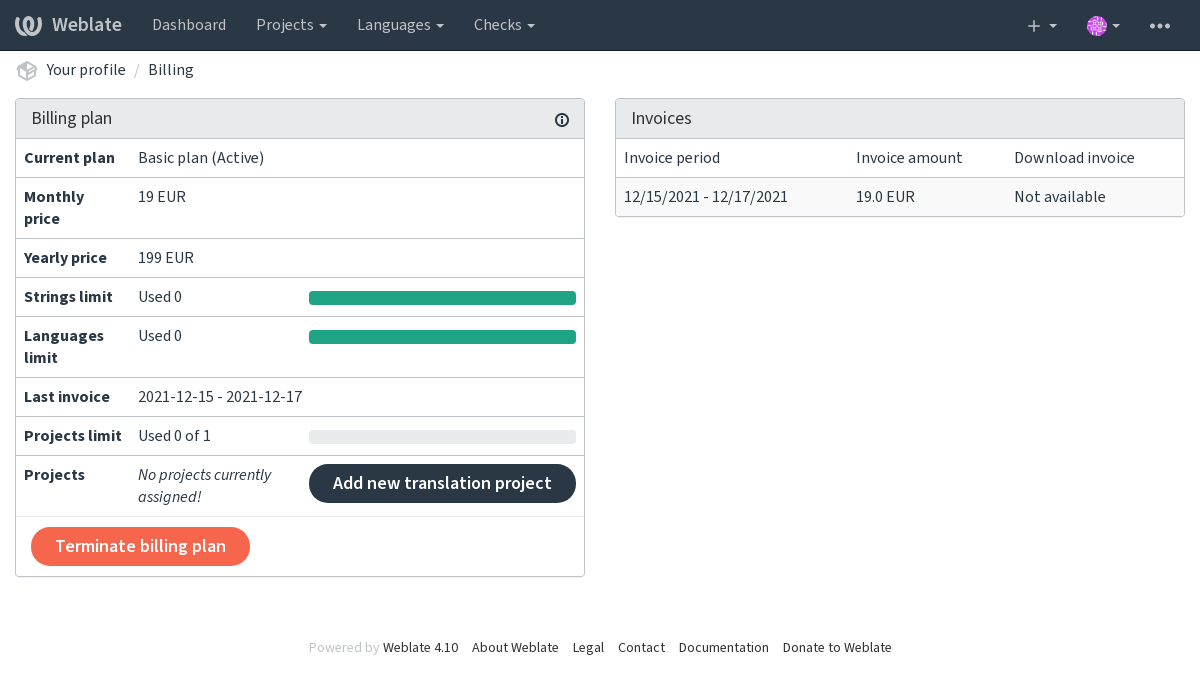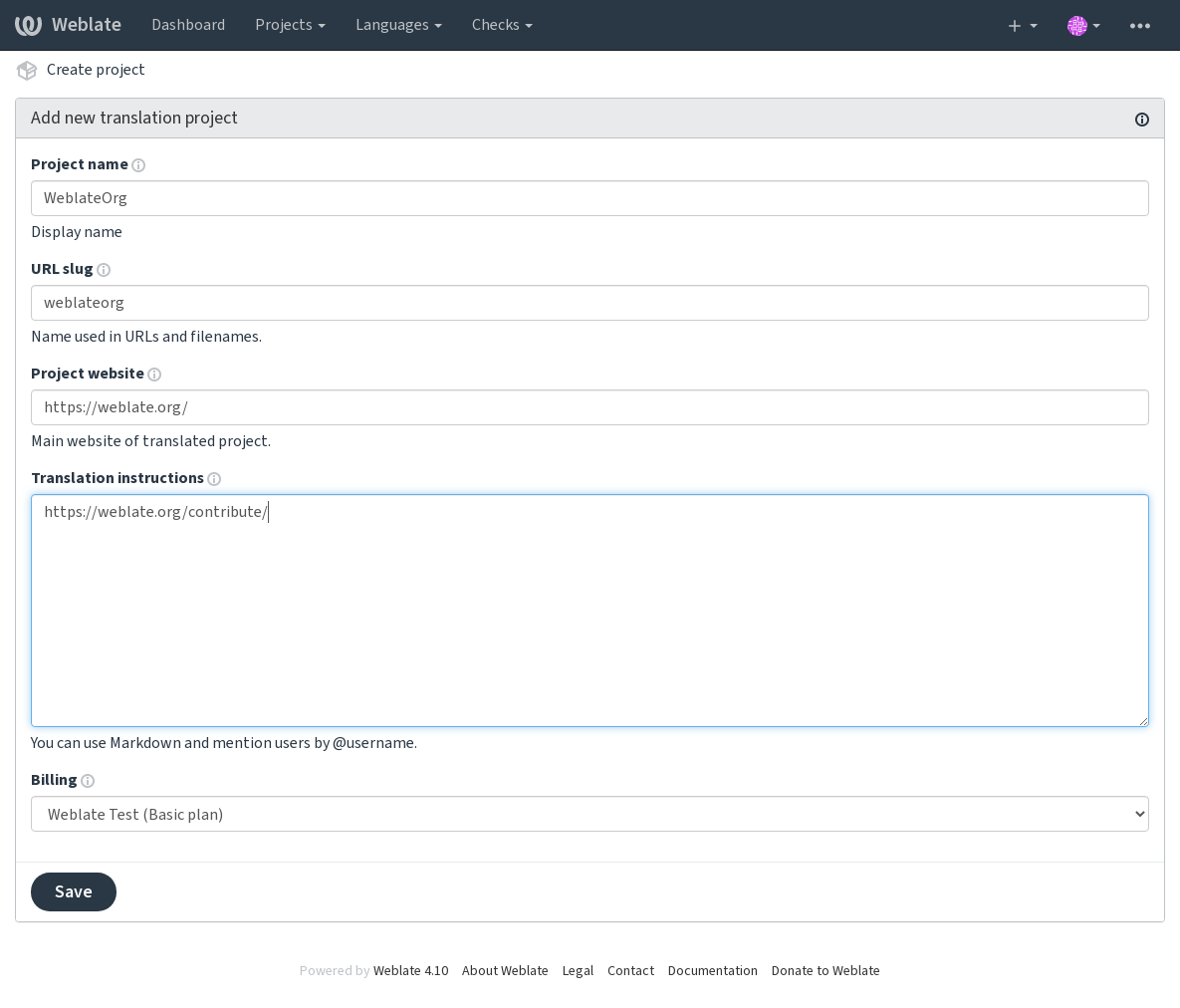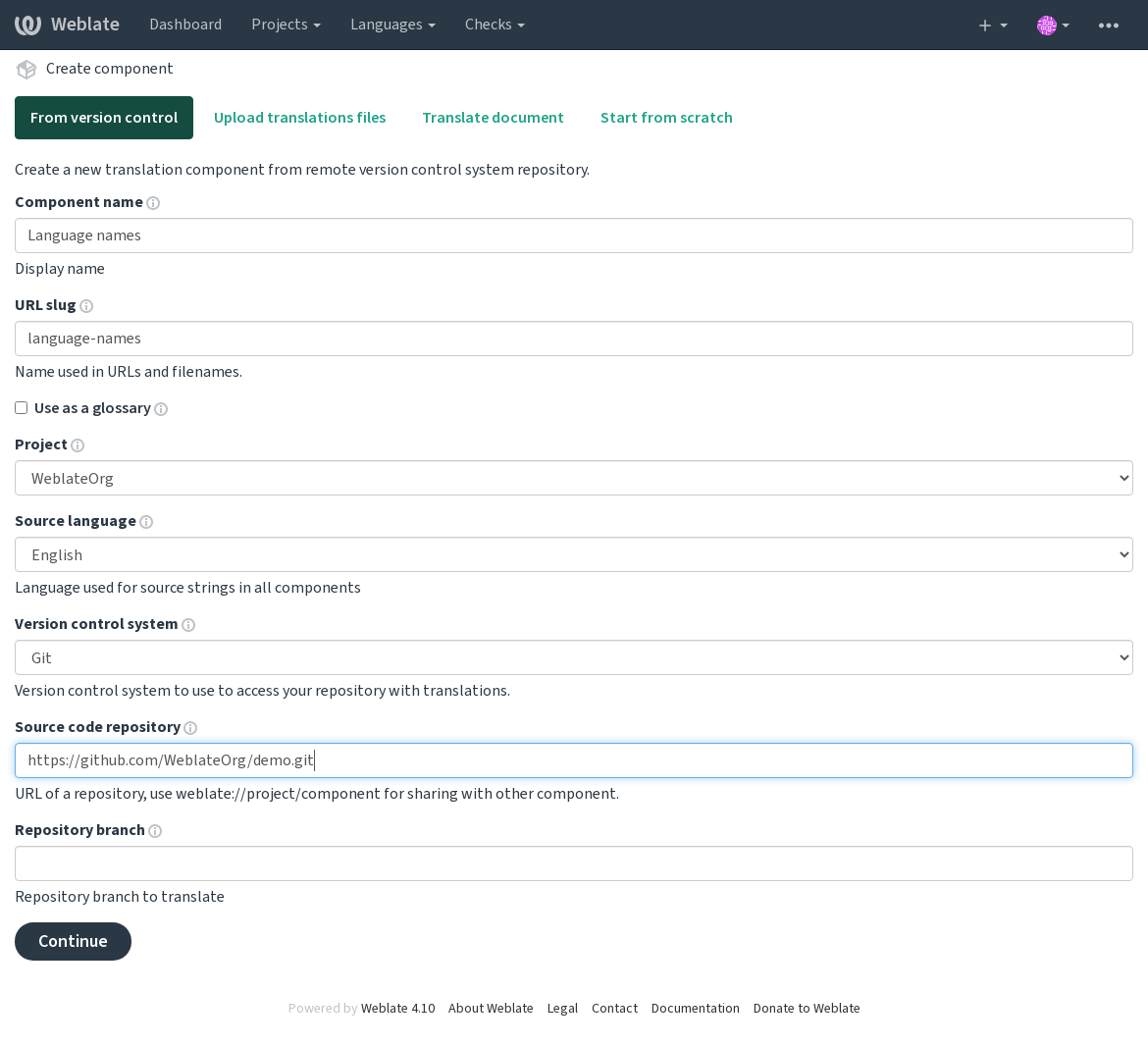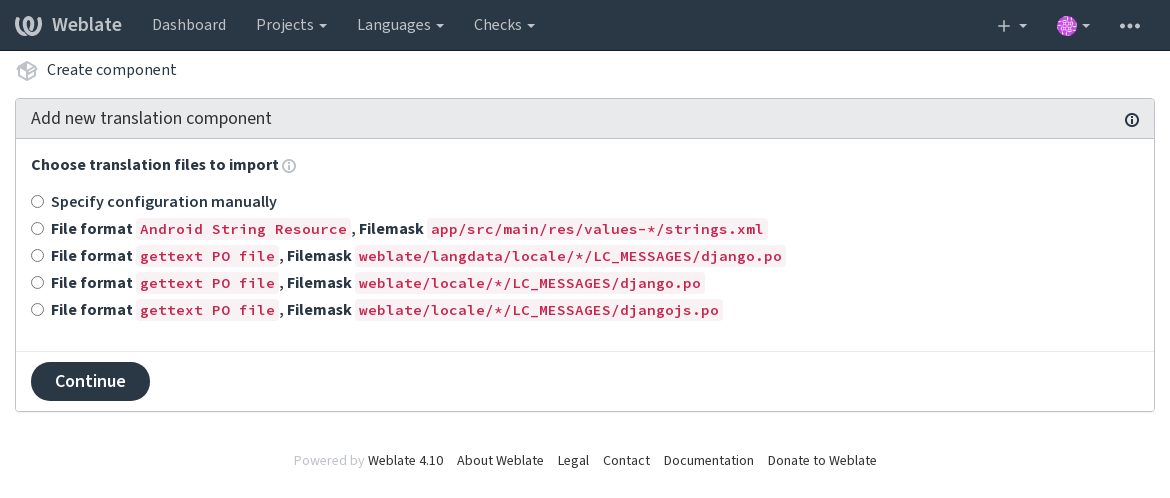Çeviri projeleri
Translation organization
Weblate organizes translatable VCS content of project/components into a tree-like structure.
The bottom level object is Project configuration, which should hold all translations belonging together (for example translation of an application in several versions and/or accompanying documentation).
On the level above, Component configuration, which is actually the component to translate, you define the VCS repository to use, and the mask of files to translate.
Above Component configuration there are individual translations, handled automatically by Weblate as translation files (which match File mask defined in Component configuration) appear in the VCS repository.
Weblate supports a wide range of translation formats (both bilingual and monolingual ones) supported by Translate Toolkit, see Supported file formats.
Not
You can share cloned VCS repositories using Weblate internal URLs. Using this feature is highly recommended when you have many components sharing the same VCS. It improves performance and decreases required disk space.
Adding translation projects and components
3.2 sürümünde değişti: An interface for adding projects and components is included, and you no longer have to use The Django admin interface.
3.4 sürümünde değişti: The process of adding components is now multi staged, with automated discovery of most parameters.
Based on your permissions, new translation projects and components can be created. It is always permitted for users with the Add new projects permission, and if your instance uses billing (e.g. like https://hosted.weblate.org/ see Faturalandırma), you can also create those based on your plans allowance from the user account that manages billing.
You can view your current billing plan on a separate page:

The project creation can be initiated from there, or using the menu in the navigation bar, filling in basic info about the translation project to complete addition of it:

After creating the project, you are taken directly to the project page:

Creating a new translation component can be initiated via a single click there. The process of creating a component is multi-staged and automatically detects most translation parameters. There are several approaches to creating component:
- Sürüm denetiminden
Creates component from remote version control repository.
- Mevcut bileşenden
Creates additional component to existing one by choosing different files.
- Ek dal
Creates additional component to existing one, just for different branch.
- Çeviri dosyalarını yükle
Upload translation files to Weblate in case you do not have version control or do not want to integrate it with Weblate. You can later update the content using the web interface or Weblate’s REST API.
- Belgeyi çevir
Upload single document or translation file and translate that.
- Sıfırdan başla
Create blank translation project and add strings manually.
Once you have existing translation components, you can also easily add new ones for additional files or branches using same repository.
First you need to fill in name and repository location:

On the next page, you are presented with a list of discovered translatable resources:

As a last step, you review the translation component info and fill in optional details:

Ayrıca bakınız
The Django admin interface, Project configuration, Component configuration
Project configuration
Create a translation project and then add a new component for translation in it. The project is like a shelf, in which real translations are stacked. All components in the same project share suggestions and their dictionary; the translations are also automatically propagated through all components in a single project (unless turned off in the component configuration), see Çeviri Belleği.
Ayrıca bakınız
These basic attributes set up and inform translators of a project:
Proje adı
Verbose project name, used to display the project name.
URL kısaltması
Project name suitable for URLs.
Proje web sitesi
URL where translators can find more info about the project.
This is a required parameter unless turned off by WEBSITE_REQUIRED.
Çeviri talimatları
Text describing localization process in the project, and any other information useful for translators. Markdown can be used for text formatting or inserting links.
“Language-Team” (Çeviri-Takımı) başlığını ayarla
Whether Weblate should manage the Language-Team header (this is a
GNU gettext only feature right now).
Erişim denetimi
Configure per project access control, see Proje erişim kontrolü for more details.
Default value can be changed by DEFAULT_ACCESS_CONTROL.
Gözden geçirmeleri etkinleştir
Enable review workflow for translations, see Dedicated reviewers.
Kaynak gözden geçirmelerini etkinleştir
Enable review workflow for source strings, see Source strings reviews.
Ayrıca bakınız
Kancaları etkinleştir
Whether unauthenticated Bildirim kancaları are to be used for this repository.
Dil kod adları
Define language codes mapping when importing translations into Weblate. Use this when language codes are inconsistent in your repositories and you want to get a consistent view in Weblate or in case you want to use non-standard naming of your translation files.
The typical use case might be mapping American English to English: en_US:en
Multiple mappings to be separated by comma: en_GB:en,en_US:en
Using non standard code: ia_FOO:ia
İpucu
The language codes are mapped when matching the translation files and the matches are case sensitive, so make sure you use the source language codes in same form as used in the filenames.
Ayrıca bakınız
Component configuration
A component is a grouping of something for translation. You enter a VCS repository location and file mask for which files you want translated, and Weblate automatically fetches from this VCS, and finds all matching translatable files.
Ayrıca bakınız
You can find some examples of typical configurations in the Supported file formats.
Not
It is recommended to keep translation components to a reasonable size - split the translation by anything that makes sense in your case (individual apps or addons, book chapters or websites).
Weblate easily handles translations with 10000s of strings, but it is harder to split work and coordinate among translators with such large translation components.
Should the language definition for a translation be missing, an empty definition is created and named as “cs_CZ (generated)”. You should adjust the definition and report this back to the Weblate authors, so that the missing languages can be included in next release.
The component contains all important parameters for working with the VCS, and for getting translations out of it:
Bileşen adı
Verbose component name, used to display the component name.
Component slug
Component name suitable for URLs.
Component project
Project configuration where the component belongs.
Sürüm denetleme sistemi
VCS to use, see Sürüm denetimi tümleşimi for details.
Ayrıca bakınız
Kaynak kod deposu
VCS repository used to pull changes.
Ayrıca bakınız
See Accessing repositories for more details on specifying URLs.
İpucu
This can either be a real VCS URL or weblate://project/component
indicating that the repository should be shared with another component.
See Weblate internal URLs for more details.
Depo yollama URL’si
Repository URL used for pushing. This setting is used only for Git and Mercurial and push support is turned off for these when this is empty.
For linked repositories, this is not used and setting from linked component applies.
Ayrıca bakınız
See Accessing repositories for more details on how to specify a repository URL and Pushing changes from Weblate for more details on pushing changes from Weblate.
Depo tarayıcısı
URL of repository browser used to display source files (location of used messages). When empty, no such links will be generated. You can use Template markup.
For example on GitHub, use something like:
https://github.com/WeblateOrg/hello/blob/{{branch}}/{{filename}}#L{{line}}
In case your paths are relative to different folder (path contains ..), you
might want to strip leading directory by parentdir filter (see
Template markup):
https://github.com/WeblateOrg/hello/blob/{{branch}}/{{filename|parentdir}}#L{{line}}
Dışa aktarılmış depo URL’si
URL where changes made by Weblate are exported. This is important when Sürekli yerelleştirme is not used, or when there is a need to manually merge changes. You can use Git exporter to automate this for Git repositories.
Depo dalı
Which branch to checkout from the VCS, and where to look for translations.
For linked repositories, this is not used and setting from linked component applies.
Yollama dalı
Branch for pushing changes, leave empty to use Depo dalı.
For linked repositories, this is not used and setting from linked component applies.
Not
This is currently only supported for Git, GitLab and GitHub, it is ignored for other VCS integrations.
Ayrıca bakınız
File mask
Mask of files to translate, including path. It should include one “*” replacing language code (see Dil tanımları for info on how this is processed). In case your repository contains more than one translation file (e.g. more gettext domains), you need to create a component for each of them.
For example po/*.po or locale/*/LC_MESSAGES/django.po.
In case your filename contains special characters such as [, ], these need
to be escaped as [[] or []].
Tek dilli taban dil dosyası
Base file containing string definitions for Monolingual components.
Taban dosyayı düzenle
Whether to allow editing the base file for Monolingual components.
Ara dil dosyası
Intermediate language file for Monolingual components. In most cases this is a translation file provided by developers and is used when creating actual source strings.
When set, the source strings are based on this file, but all other languages are based on Tek dilli taban dil dosyası. In case the string is not translated into the source langugage, translating to other languages is prohibited. This provides Quality gateway for the source strings.
Yeni çeviriler için şablon
Base file used to generate new translations, e.g. .pot file with gettext.
İpucu
In many monolingual formats Weblate starts with blank file by default. Use this in case you want to have all strings present with empty value when creating new translation.
Dosya biçimi
Translation file format, see also Supported file formats.
Kaynak dizgi hata bildirme adresi
Email address used for reporting upstream bugs. This address will also receive notification about any source string comments made in Weblate.
Çeviri yaymaya izin ver
You can turn off propagation of translations to this component from other components within same project. This really depends on what you are translating, sometimes it’s desirable to have make use of a translation more than once.
It’s usually a good idea to turn this off for monolingual translations, unless you are using the same IDs across the whole project.
Default value can be changed by DEFAULT_TRANSLATION_PROPAGATION.
Ayrıca bakınız
Önerileri etkinleştir
Whether translation suggestions are accepted for this component.
Öneri oylaması
Turns on vote casting for suggestions, see Öneri oylaması.
Önerileri kendiliğinden kabul et
Automatically accept voted suggestions, see Öneri oylaması.
Çeviri işaretleri
Customization of quality checks and other Weblate behavior, see Customizing behavior using flags.
Zorunlu denetimler
List of checks which can not be ignored, see Enforcing checks.
Not
Enforcing the check does not automatically enable it, you still should enabled it using Customizing behavior using flags in Çeviri işaretleri or Additional info on source strings.
Çeviri lisansı
License of the translation (does not need to be the same as the source code license).
Katılımcı sözleşmesi
Bir kullanıcının bu bileşeni çevirmeden önce onaylaması gereken kullanıcı sözleşmesi.
Yeni çeviri ekleniyor
How to handle requests for creation of new languages. Available options:
- İletişim sorumlusu
User can select desired language and the project maintainers will receive a notification about this. It is up to them to add (or not) the language to the repository.
- Çeviri talimatları URL’sini göster
User is presented a link to page which describes process of starting new translations. Use this in case more formal process is desired (for example forming a team of people before starting actual translation).
- Yeni dil dosyası oluştur
User can select language and Weblate automatically creates the file for it and translation can begin.
- Yeni çeviri ekleme devre dışı
There will be no option for user to start new translation.
İpucu
The project admins can add new translations even if it is disabled here when it is possible (either Yeni çeviriler için şablon or the file format supports starting from an empty file).
Ayrıca bakınız
Dizgileri yönet
4.5 sürümünde geldi.
Configures whether users in Weblate will be allowed to add new strings and remove existing ones. Adjust this to match your localization workflow - how the new strings are supposed to be introduced.
For bilingual formats, the strings are typically extracted from the source code (for example by using xgettext) and adding new strings in Weblate should be disabled (they would be discarded next time you update the translation files). In Weblate you can manage strings for every translation and it does not enforce the strings in all translations to be consistent.
For monolingual formats, the strings are managed only on source language and are automatically added or removed in the translations. The strings appear in the translation files once they are translated.
Dil kodu stili
Weblate tarafından oluşturulan çeviriler için dosya adını oluşturmak için kullanılan dil kodunu özelleştirin.
Ayrıca bakınız
Birleştirme stili
You can configure how updates from the upstream repository are handled. This might not be supported for some VCSs. See Merge or rebase for more details.
Default value can be changed by DEFAULT_MERGE_STYLE.
Commit, add, delete, merge and addon messages
Message used when committing a translation, see Template markup.
Default value can be changed by DEFAULT_ADD_MESSAGE,
DEFAULT_ADDON_MESSAGE, DEFAULT_COMMIT_MESSAGE,
DEFAULT_DELETE_MESSAGE, DEFAULT_MERGE_MESSAGE.
İşlemeye yolla
Whether committed changes should be automatically pushed to the upstream repository. When enabled, the push is initiated once Weblate commits changes to its underlying repository (see Lazy commits). To actually enable pushing Repository push URL has to be configured as well.
İşlenecek değişikliklerin yaşı
Sets how old (in hours) changes have to be before they are committed by
background task or the commit_pending management command. All
changes in a component are committed once there is at least one change
older than this period.
Default value can be changed by COMMIT_PENDING_HOURS.
İpucu
There are other situations where pending changes might be committed, see Lazy commits.
Hata durumunda kilitle
Locks the component (and linked components, see Weblate internal URLs) upon the first failed push or merge into its upstream repository, or pull from it. This avoids adding another conflicts, which would have to be resolved manually.
The component will be automatically unlocked once there are no repository errors left.
Kaynak dil
Language used for source strings. Change this if you are translating from something else than English.
İpucu
In case you are translating bilingual files from English, but want to be able to do fixes in the English translation as well, choose English (Developer) as a source language to avoid conflict between the name of the source language and the existing translation.
For monolingual translations, you can use intermediate translation in this case, see Ara dil dosyası.
Dil süzgeci
Dosya maskesi taranırken çeviriyi süzmek için kullanılan düzenli ifade. Weblate tarafından yönetilen dillerin listesini sınırlamak için kullanılabilir.
Not
You need to list language codes as they appear in the filename.
Some examples of filtering:
Filter description |
Düzenli ifade |
|---|---|
Selected languages only |
|
Exclude languages |
|
Filter two letter codes only |
|
Exclude non language files |
|
Include all files (default) |
|
Çeşitlerin düzenli ifadesi
Regular expression used to determine the variants of a string, see String variants.
Not
Most of the fields can be edited by project owners or managers, in the Weblate interface.
Öncelik
Yüksek öncelikli bileşenler çevirmenlere ilk olarak sunulur.
Restricted access
By default the component is visible to anybody who has access to the project, even if the person can not perform any changes in the component. This makes it easier to keep translation consistency within the project.
Restricting access at a component, or component-list level takes over access permission to a component, regardless of project-level permissions. You will have to grant access to it explicitly. This can be done through granting access to a new user group and putting users in it, or using the default custom or private access control groups.
The default value can be changed in DEFAULT_RESTRICTED_COMPONENT.
İpucu
This applies to project admins as well — please make sure you will not loose access to the component after toggling the status.
Sözlük olarak kullan
4.5 sürümünde geldi.
Bu bileşenin sözlük olarak kullanılmasına izin verir. Nasıl listeleneceğini Sözlük rengi kullanarak yapılandırabilirsiniz.
The glossary will be accessible in all projects defined by Projelerde paylaş.
It is recommended to enable Dizgileri yönet on glossaries in order to allow adding new words to them.
Ayrıca bakınız
Sözlük rengi
Display color for a glossary used when showing word matches.
Template markup
Weblate uses simple markup language in several places where text rendering is needed. It is based on The Django template language, so it can be quite powerful.
Currently it is used in:
Commit message formatting, see Component configuration
- Several addons
There following variables are available in the component templates:
{{ language_code }}Dil kodu
{{ language_name }}Dil adı
{{ component_name }}Bileşen adı
{{ component_slug }}Component slug
{{ project_name }}Proje adı
{{ project_slug }}Project slug
{{ url }}Translation URL
{{ filename }}Çeviri dosya adı
{{ stats }}Translation stats, this has further attributes, examples below.
{{ stats.all }}Total strings count
{{ stats.fuzzy }}Count of strings needing review
{{ stats.fuzzy_percent }}Percent of strings needing review
{{ stats.translated }}Translated strings count
{{ stats.translated_percent }}Translated strings percent
{{ stats.allchecks }}Number of strings with failing checks
{{ stats.allchecks_percent }}Percent of strings with failing checks
{{ author }}Author of current commit, available only in the commit scope.
{{ addon_name }}Name of currently executed addon, available only in the addon commit message.
The following variables are available in the repository browser or editor templates:
{{branch}}current branch
{{line}}line in file
{{filename}}filename, you can also strip leading parts using the
parentdirfilter, for example{{filename|parentdir}}
You can combine them with filters:
{{ component|title }}
You can use conditions:
{% if stats.translated_percent > 80 %}Well translated!{% endif %}
There is additional tag available for replacing characters:
{% replace component "-" " " %}
You can combine it with filters:
{% replace component|capfirst "-" " " %}
There are also additional filter to manipulate with filenames:
Directory of a file: {{ filename|dirname }}
File without extension: {{ filename|stripext }}
File in parent dir: {{ filename|parentdir }}
It can be used multiple times: {{ filename|parentdir|parentdir }}
…and other Django template features.
Importing speed
Fetching VCS repository and importing translations to Weblate can be a lengthy process, depending on size of your translations. Here are some tips:
Optimize configuration
The default configuration is useful for testing and debugging Weblate, while for a production setup, you should do some adjustments. Many of them have quite a big impact on performance. Please check Production setup for more details, especially:
Configure Celery for executing background tasks (see Background tasks using Celery)
Check resource limits
If you are importing huge translations or repositories, you might be hit by resource limitations of your server.
Check the amount of free memory, having translation files cached by the operating system will greatly improve performance.
Disk operations might be bottleneck if there is a lot of strings to process—the disk is pushed by both Weblate and the database.
Additional CPU cores might help improve performance of background tasks (see Background tasks using Celery).
Disable unneeded checks
Some quality checks can be quite expensive, and if not needed,
can save you some time during import if omitted. See CHECK_LIST for
info on configuration.
Automatic creation of components
In case your project has dozen of translation files (e.g. for different
gettext domains, or parts of Android apps), you might want to import them
automatically. This can either be achieved from the command-line by using
import_project or import_json, or by installing the
Bileşen keşfi addon.
To use the addon, you first need to create a component for one translation file (choose the one that is the least likely to be renamed or removed in future), and install the addon on this component.
For the management commands, you need to create a project which will contain all
components and then run import_project or
import_json.
Ayrıca bakınız